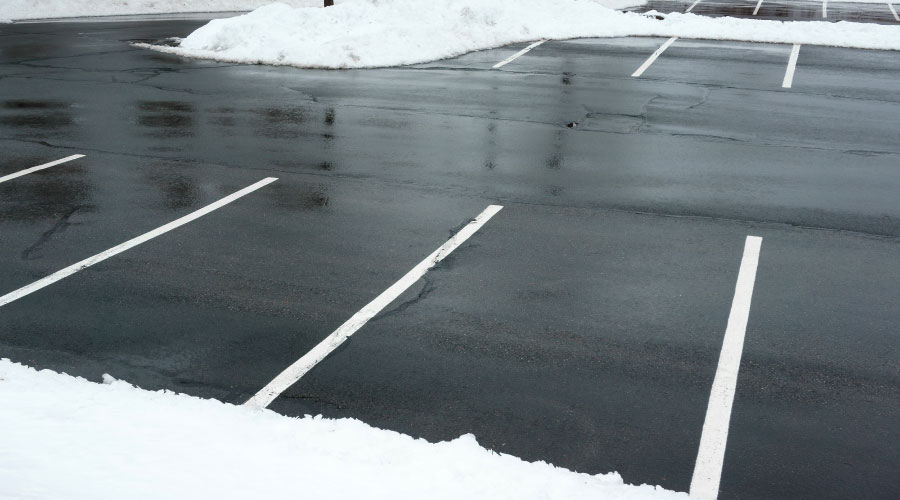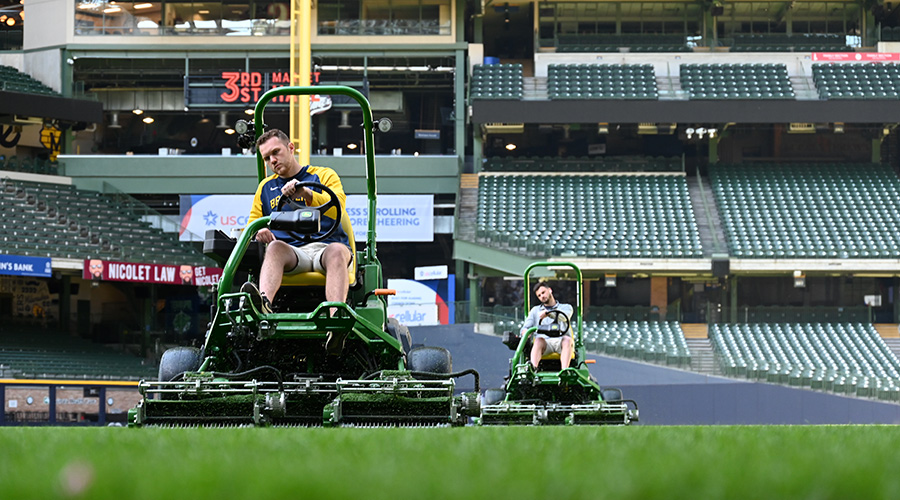Hot Buttons for Colder Weather
Equipment and staffing top the list of priorities for managers preparing their departments for the challenges of winter
For grounds managers, the approach of cooler weather is a time to begin planning for the unique challenges that cold weather can pose for grounds operations. Successful planning begins with a winter-preparedness plan that addresses needs related to personnel, equipment and landscaping resources.
For departments without such a plan in place, creating and implementing one is essential. Plans can range from the simple to the very detailed, and they inevitably expand as managers add further detail each year.
Clarity is especially essential, even if a plan is relatively simple or a manager is only beginning to formulate one. The plan should clearly outline specific areas of responsibility and expected outcomes so facility executives and front-line workers also can share in the expectations concerning service levels.
Managers should distribute the plan to related departments, including those involved in public safety, internal communications and community relations.
Starting Early
Ken Stanton, a certified grounds manager (CGM) and grounds supervisor with Grand Valley State University in Allendale, Mich., says his department’s preparation for winter months and the ensuing snowfall begin in June with the purchase of road salt. The university’s 500-acre campus receives an average 72 inches of lake-effect snowfall annually.
Most of the campus’s winter preparations take place in August and September, Stanton says. During this time, the focus of grounds operations turns from turf and arbor care to activities related to combating snow and ice.
These activities include securing competitive pricing for deicers and salt, preparing rental agreements for equipment to supplement the use of in-house tools, and finalizing contracts with outside equipment and service providers.
Equipment Matters
Next, a department’s focus turns to its equipment. Operators and mechanics first should inspect and, if needed, repair dump trucks used for plowing and salting, along with tractors, pickup trucks, sanders, snowplows, snow blowers, and salt spreaders.
“Once all the equipment is loaded, hooked up and made ready to go, this is a good time to do a dry run for the fast-approaching winter,” says Jeff Horst, CGM, buildings and grounds director at Vassar College in Poughkeepsie, N.Y. He recommends using Thanksgiving as a deadline for such a dry run.
When it comes to preparing equipment, managers will need to consider two additional issues: equipment storage and advance coordination between operators and mechanics.
Operators need to clean, maintain and store mowers, string trimmers and spray equipment in a separate location away from the main storage area, says Greg Nichols, assistant director of grounds at Bryn Mawr (Pa.) College, which includes 60 acres of turf area. It is crucial that grounds managers secure the resources necessary for this process, since the need to cut grass can overlap with early spring and late fall snow removal.
“Whether you are getting out your snow blowers or salt spreaders, you don’t want to be tripping over or having to navigate around mowers or trimmers that aren’t going to be used for months,” says Nichols, who also serves on the board of directors for the Professional Grounds Management Society (PGMS).
An effective winter-preparation plan not only determines the most effective strategy for equipment storage. It also provides a timeline detailing worker responsibilities for specific activities and areas of the grounds, as well as their timing. Since winter storms can differ in magnitude, such a plan also should describe the responsibilities of team members under different weather scenarios. Horst also recommends meeting with all equipment operators before severe storms.
“I find that if these front-line people are involved in the planning phase, the operation goes much smoother than a manager simply scheduling the work,” he says.
Beyond inspection and preparation, another key to preserving an operation’s grounds staff is having proper equipment. Buying the most efficient equipment is an investment in the well-being of the grounds team.
“This is an investment you just don’t want to skimp on,” Nichols says. “Spending more on equipment that gets the job done quicker will prevent your employees from getting as tired. Avoiding fatigue is crucial because it increases the probability of injury to your workers.”
Turf and Plant Issues
Once crews address equipment preparation, it is equally important to prepare turf and landscaped areas for cooler weather. Keeping plants healthy as they enter their dormant period is important for ensuring they will survive and look their best when warmer weather returns.
Workers should give plenty of water to trees and shrubs planted in the past three years. This tactic decreases the chances for winter desiccation injury.
The winter-preparedness plan also should outline the types of plants appropriate for each location. For example, large snowfalls on the Grand Valley State campus used to create excessive damage to shrubs. As a result, during spring and summer, the department would precious spend time and money replacing damaged shrubs.
Stanton suggests preventing this annual expense by converting existing shrub-bed plantings to perennials and ornamental grasses, either separate or mixed in with shrubs that were able to tolerate heavy snow loads. He also recommends reviewing landscaping plans for new buildings and areas to make sure new beds consist of these winter-resilient materials.
Salt is the primary concern when it comes to turf care. Along driveways and near low runoff areas, managers should consider having workers aerate and apply gypsum, which can help soften the destructive accumulation of salt in turf.
“A soil profile that allows the salts to be flushed through it stands a better chance of survival than those that hold the salt for prolonged periods of time,” Nichols says.
Staffing Shifts
Personnel are perhaps the most important resources covered by a winter-preparedness plan. The duties of most grounds-management employees change drastically with the arrival of winter.
During the growing season, each person is responsible for specific duties. One person might have all pruning responsibilities, a team of five workers might be responsible for all string trimming and general grounds tasks, and another team might focus on caring for athletic fields.
A zone maintenance strategy can extend to snow removal, with grounds workers responsible for shoveling, blowing snow and deicing in specific areas. When crews have completed all work related to snow, they can shift to pruning trees, reclaiming landscaped areas, working on trails and clearing brush.
While severe weather often requires 24-hour coverage by a grounds crew, the added tasks can stretch staffing resources to the limit. To prevent worker injuries, the plan should limit the number of hours employees can work, and supervisors should monitor crew members for proper foul-weather clothing and check with equipment operators to make sure they are alert and operating safely.
Additional ideas to maintain employee safety and sanity during severe weather include arranging sleeping quarters on site, organizing a pool of extra employees from other departments within facilities management — mechanical, electrical, plumbing, carpentry, etc. — and making emergency arrangements with outside contractors well in advance.
Regardless of the level of detail contained in an organization’s winter-preparedness plan is, room for improvement always exists. Did any problems arise or injuries occur this year? If so, how can managers address the cause of such problems?
It is critical to regularly review the plan’s effectiveness and make appropriate revisions. Managers also should account for any equipment changes or staff turnover in the plan.
It is never pleasant to think of winter during the summer months, but for those who want to maximize their grounds operations it is a necessary process. With a well-thought-out winter-preparedness plan, managers will have fewer problems when a storm hits, and during those long winter months, they will have more time to entertain thoughts of summer.
Eric Grammer is communications manager for the Professional Grounds Management Society, www.pgms.org.
Plowing Priorities
Whether the landscaped site in question has just 5 acres or more than 1,000, grounds managers must prioritize snow removal and ice control for all paved areas. This step is essential in producing a successful winter-preparation plan and, more importantly, ensuring safe parking lots and sidewalks.
For example, which facility or area must open first? What is the next most important facility? Should plows clear parking lots first, or are pathways from facilities to parking lots higher priorities? What about access for emergency vehicles? Are on-site residents up and about early?
Safety should guide the sequence of tasks, as well as the procedures for closing a facility. Just because all walkways and parking lots are accessible doesn’t mean the facility should open or remain so.
Managers must monitor conditions outside the site, especially roads, and factor that information into any final decision on whether to keep a facility open.
— Eric Grammer
|
Related Topics:











